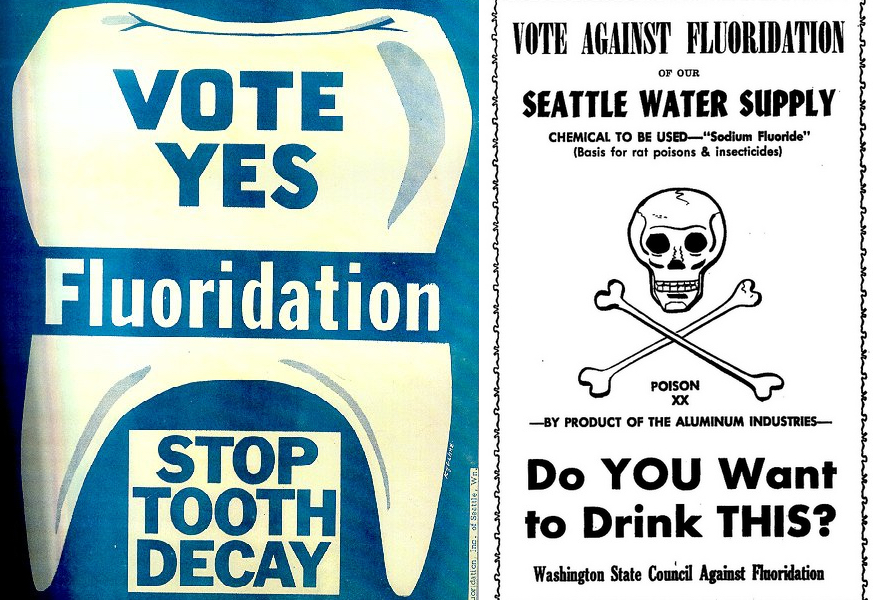Effort to ban fluoride in drinking water makes little headway in Michigan
Readers of a certain age may recall a once-ubiquitous accessory in their grandparents’ bathroom: The vessel that held grandmother’s teeth at night. Dentures were so common they were thought to be unavoidable past a certain age.
That’s not the case anymore, and the scientific community points to multiple factors keeping more elderly Americans united with their original equipment – brushing, flossing, better dental care across the course of a lifetime and one factor above all: fluoride.
Fluoride, not just in toothpaste but as an additive to municipal water supplies, has had a positive, even transformative effect on the nation’s dental health. Of this the dental establishment speaks with one voice when it affirms it uniformly good for children and adults. The U.S. Centers for Disease Control agrees, naming fluoridation one of the 10 great public health achievements of the 20th century. (The CDC says the same thing about vaccinations, too, but that hasn’t necessarily quelled resistance in some pockets of Michigan to vaccines.)
While hardly widespread, a nascent anti-fluoridation movement is being heard in Michigan, where large-scale fluoridation got its start, in Grand Rapids in 1945.
Americans have been debating fluoridation since its widespread adoption in the 1940s and ‘50s, when cold-war paranoiacs saw it as a Communist plot to make populations more amenable to domination. Grand Rapids’ place at the vanguard spared it from the most vocal objections, which didn’t catch on until later. Today, the city proudly tells its story in the history of the movement on the municipal website.
MORE COVERAGE: Improved smiles for some low-income Michigan children
As with the anti-vaccine movement, the push to stop adding fluoride to public drinking water appears to be one where some within the natural-health movement are finding common cause with tea-party, anti-government sentiment. So far, however, the alliance’s efforts have had only minor success in Michigan.
Last year, Boyne City, the Charlevoix County home to 3,735, took up the issue at the prompting of City Commissioner Laura Sansom, who started reading online about perceived concerns about fluoride as part of the commission’s budget work.
“I thought, if it’s not necessary, maybe we don’t have to use it,” Sansom told Bridge in an interview. “We had been adding it for 40 years, and I wanted to revisit the issue. I didn’t know that much about it. I looked into it, and became alarmed.”
Looking into fluoride these days can lead Googlers down vast warrens of Internet rabbit holes, where dozens of sites warn that fluoride in water is actually a toxic-waste product of fertilizer, that it contains multiple toxins, leeches calcium from the bones, deposits aluminum in the brain and is simply an all-around threat to health far outweighing its benefit to teeth. Certainly, there is mainstream scientific evidence that too much fluoride can be harmful to the body, with the World Health Organization noting regions where high concentrations of the chemical already exist naturally in the water supply. Sansom said she believes all of the above alleged effects of fluoride make it something she wants no part of.
The Boyne City Commission has five members. Sansom persuaded two other members to join her in a bloc, and in early 2014 the three of them successfully voted to stop adding fluoride to the city’s water supply, which has about 1,300 hookups.
But Boyne City is also where the Michigan Community Dental Clinics have their corporate offices, and the company’s now-retired CEO, Dr. Thomas Veryser ‒ yes, a dentist ‒ said he was not impressed by the commission’s research.
“Laura Sansom determined she was being poisoned by the fluoride in the water,” he scoffed. “She became obsessed.”
There were public meetings that attracted both pro- and anti-fluoridation voices, including “outside agitators from Traverse City” who spoke against it, he said, and public-health officials in favor. But the 3-2 vote to remove fluoride, Veryser said, was a fait accompli.
Undeterred, Veryser swung into action with other pro-fluoride advocates. They organized a petition drive and successfully put the question on the November 2014 ballot. The result was resoundingly in favor of fluoride – nearly 70 percent voted to have the city add it back to Boyne City’s drinking water.
In a small town, it’s problematic to hold grudges. Sansom says she bears none against her neighbors, and accepted the vote with equanimity.
“I do not drink tap water,” she said. “I use fluoride-free toothpaste. I buy reverse-osmosis bottled water, because that’s the only kind you can get without it. But I’m not going around badmouthing anyone. The vote is the vote.”
Boyne City isn’t the only place in Michigan to raise resistance to putting fluoride in the water supply.
Southeast Michigan’s Hartland Township removed fluoride in 2011. And though there was “one township board member with a strong opinion about this,” township manager James Wickman said the decision was financial, based on a trait of the city’s well-drawn water supply: It already has a fairly high level of naturally occurring fluoride.
Fluoride occurs naturally in some groundwater. In fact, the first researchers to find the link between fluoride and improved dental health did so by observing decay patterns in people who drank from different sources. Very high natural concentrations in wells gave drinkers stained teeth, but few cavities. Once the connection was discovered, effort was focused on finding an optimal level that would protect teeth without turning them brown or causing more serious conditions such as skeletal fluorosis.
The CDC now recommends a fluoride concentration of .7 milligrams per liter, down from a previous range of .7-1.2 mpl, in part because the use of fluoride toothpaste is widespread in the U.S.
“It turns out our water already comes out of the ground at .42 (mpl),” said Wickman. “It’s good enough.”
See what new members are saying about why they donated to Bridge Michigan:
- “In order for this information to be accurate and unbiased it must be underwritten by its readers, not by special interests.” - Larry S.
- “Not many other media sources report on the topics Bridge does.” - Susan B.
- “Your journalism is outstanding and rare these days.” - Mark S.
If you want to ensure the future of nonpartisan, nonprofit Michigan journalism, please become a member today. You, too, will be asked why you donated and maybe we'll feature your quote next time!


 Fluoride was first added to municipal drinking water in the 1940s, with Grand Rapids leading the way. While the scientific and dental communities broadly support fluoride’s benefits, the issue was controversial from the beginning, as these materials from King County, Wash., circa 1951, attest. (Images from King County via Flickr; used under Creative Commons license)
Fluoride was first added to municipal drinking water in the 1940s, with Grand Rapids leading the way. While the scientific and dental communities broadly support fluoride’s benefits, the issue was controversial from the beginning, as these materials from King County, Wash., circa 1951, attest. (Images from King County via Flickr; used under Creative Commons license) Boyne City Commissioner Laura Sansom says that research that led her to raise oncerns about the safety of putting fluoride in drinking water drove her vote to successfully stop the practice. Residents later overturned that decision.
Boyne City Commissioner Laura Sansom says that research that led her to raise oncerns about the safety of putting fluoride in drinking water drove her vote to successfully stop the practice. Residents later overturned that decision.